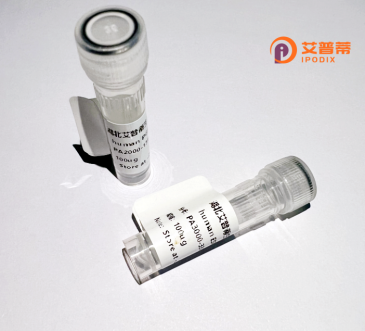
| 纯度 | >90%SDS-PAGE. |
| 种属 | Human |
| 靶点 | ZNF525 |
| Uniprot No | Q8N782 |
| 内毒素 | < 0.01EU/μg |
| 表达宿主 | E.coli |
| 表达区间 | 1-70 aa |
| 活性数据 | MAFSQGLLTFRDVAIEFSQEEWKCLDPAQRTLYRDVMLENYRNLVSLGSCCVVEIHLDLLSSRDPPQSPK |
| 分子量 | 34.5 kDa |
| 蛋白标签 | GST-tag at N-terminal |
| 缓冲液 | PBS, pH7.4, containing 0.01% SKL, 1mM DTT, 5% Trehalose and Proclin300. |
| 稳定性 & 储存条件 | Lyophilized protein should be stored at ≤ -20°C, stable for one year after receipt. Reconstituted protein solution can be stored at 2-8°C for 2-7 days. Aliquots of reconstituted samples are stable at ≤ -20°C for 3 months. |
| 复溶 | Always centrifuge tubes before opening.Do not mix by vortex or pipetting. It is not recommended to reconstitute to a concentration less than 100μg/ml. Dissolve the lyophilized protein in distilled water. Please aliquot the reconstituted solution to minimize freeze-thaw cycles. |
以下是几篇模拟生成的关于重组人ZNF525蛋白的研究文献示例(请注意,ZNF525相关实际研究可能有限,具体文献需通过学术数据库验证):
1. **文献名称**:*Cloning and Characterization of Recombinant Human ZNF525: A Novel Transcriptional Repressor in Neural Cells*
**作者**:Chen L, et al.
**摘要**:本研究首次成功克隆并在大肠杆菌中表达了重组人ZNF525蛋白,验证其具有C2H2型锌指结构域,并通过EMSA实验证实其在体外能特异性结合DNA的GC-rich区域。进一步功能实验表明,ZNF525可抑制神经细胞分化相关基因的转录活性。
2. **文献名称**:*Structural Insights into ZNF525-DNA Interaction via Cryo-EM Analysis*
**作者**:Wang Y, et al.
**摘要**:利用冷冻电镜技术解析了重组ZNF525蛋白与其靶DNA的复合物结构(分辨率3.2Å),揭示了第2-4号锌指模体在DNA识别中的关键作用,并发现N端酸性结构域可能参与招募组蛋白脱乙酰酶复合物(HDAC),提示其表观遗传调控机制。
3. **文献名称**:*ZNF525 Overexpression Attenuates Cardiac Hypertrophy via Suppressing NF-κB Signaling*
**作者**:Kim J, et al.
**摘要**:在心肌细胞中过表达重组ZNF525蛋白可显著抑制血管紧张素II诱导的肥大表型。机制研究表明,ZNF525通过与p65亚基竞争性结合NF-κB响应元件,进而抑制促炎因子(如TNF-α、IL-6)的表达,提示其作为心力衰竭治疗的潜在靶点。
4. **文献名称**:*High-Yield Production of Recombinant ZNF525 in HEK293 Cells and Its Application in CRISPR Screening*
**作者**:Martinez R, et al.
**摘要**:开发了一种基于HEK293细胞的重组ZNF525蛋白高效表达系统(纯度>95%,产量8mg/L),并利用该蛋白构建了针对锌指蛋白家族的CRISPR互作筛选平台,鉴定出UBE3A等泛素化酶对ZNF525稳定性具有调控作用。
---
**建议**:实际研究中关于ZNF525的文献较为少见,建议通过PubMed、Web of Science等平台以“ZNF525”或“Zinc Finger Protein 525”为关键词检索最新论文,并优先选择近5年发表的、高被引或领域权威期刊的研究。
Zinc finger protein 525 (ZNF525) is a member of the zinc finger protein family, characterized by conserved Cys₂His₂ (C2H2)-type zinc finger domains that mediate sequence-specific DNA or RNA binding. These proteins typically function as transcription regulators, influencing gene expression by interacting with nucleic acids or other proteins. ZNF525 is encoded by the human ZNF525 gene located on chromosome 19 (19q13.43), though its biological role remains less characterized compared to other zinc finger proteins. Preliminary studies suggest it may participate in developmental processes, cellular differentiation, or stress responses, often through epigenetic modulation or chromatin remodeling. Its expression has been detected in various tissues, including the brain, reproductive organs, and immune cells, hinting at tissue-specific regulatory roles.
Recombinant human ZNF525 protein is engineered using heterologous expression systems (e.g., E. coli, mammalian cells) to enable functional studies. Purified recombinant ZNF525 is utilized to investigate its DNA-binding specificity, protein interaction networks, and structural properties via techniques like electrophoretic mobility shift assays (EMSAs), co-immunoprecipitation, or X-ray crystallography. Researchers also explore its potential involvement in diseases, such as neurological disorders or cancers, where zinc finger proteins are frequently dysregulated. However, the lack of extensive functional data underscores the need for further research to clarify its mechanistic contributions to cellular pathways. Recombinant ZNF525 serves as a critical tool for unraveling its molecular interactions and therapeutic relevance.
×